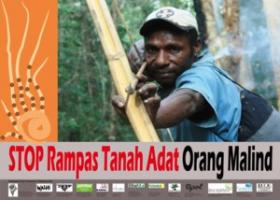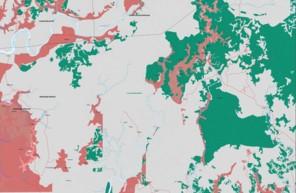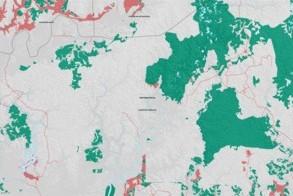
A roundup of recent material about MIFEE, January 2013, from Down To Earth
Indigenous communities living along the Bian and Maro Rivers in Merauke, southern Papua, have demanded the return of their customary lands taken for the Merauke Integrated Food and Energy Estate (MIFEE) mega-project. A set of demands issued after four days of community discussions in December also called for the revoking of location permits covering their customary land and for the companies involved to restore the damage done and pay compensation to affected communities.
A key component of the government’s unwieldy MP3EI economic masterplan for Papua, MIFEE was officially launched in 2010 amid concerns over human rights, environmental and social impacts. The project involves the conversion of indigenous land, including forests and peatlands, into plantations growing food, energy and other crops and is expected to prompt an influx of migrant workers to meet the sharply increased demand for labour .
Describing the current situation along the Bian and Maro Rivers, a document outlining the communities’ demands says that river water has been contaminated, killing fish, turtles and other water animals. It can no longer be used for drinking, cooking and bathing by the communities. Children bathing in the river and swamp waters have developed skin, digestion and respiratory problems, and now community members must walk many miles to get clean water.
Meanwhile, the destruction of customary forests has meant sources of food – including animals and sago – are becoming scarcer as are forest products needed for medicines, clothes and customary equipment.
The communities accuse the companies of failing to provide information about the land policies and permits affecting their land and failing to involve the local indigenous community organisation or many of the land right-holders in the consultation process – only engaging clan leaders and people whose land had already been cleared for development.
In addition, the communities have been misled over the status of the land leased to the companies. They were told by companies and local government that they would get their land back, but have discovered that after the 35 year lease period ends, the land will instead revert to the state – a situation to which they strongly object.[1]
A press release issued by Sawit Watch and SKP KAMe[2] adds that the Bian and Maro River community lands have been cleared by oil palm companies by burning, which has polluted the water in the rivers and swamps, damaged or wiped cultural sites and caused irreparable damage to the natural environment. These two organisations back the community demands for restoration, compensation and the return of community lands, but also call on the Indonesian government to immediately respond to the UN Committee on the Elimination of Racial Discrimination, which has raised concerns about the MIFEE project.[3]
Six oil palm plantations have currently begun operations on indigenous Malind Anim land in Merauke, according to Sawit Watch and SKP KAMe: PT Dongin Prabhawa (Korindo Group), PT Bio Inti Agrindo (Korindo Group[4]), PT Central Cipta Murdaya (CCM), PT Agriprima Cipta Persada, PT Hardaya Sawit Papua and PT Berkat Citra Abadi (Korindo Group).
There has been controversy about the official status of the land, and specifically why this region of Papua was excluded from Indonesia’s two-year moratorium on clearing primary forests and peatland, announced in May 2011.[5] Asked by REDD-Monitor’s Chris Lang why this was the case, senior government official Heru Prasetyo explained that land that had previously been classified as peatland (which would be included in the moratorium) was not as extensive as had been thought.[6] Heru Prasetyo is Deputy I UKP4,[7] and a member of the government’s REDD+ Task Force.
The moratorium map has been revised three times so far – all versions can be viewed on the Forestry Department’s website at http://webgis.dephut.go.id/. From the maps covering the MIFEE area, the reduction in the area considered to be peatland is very clear when the first and revised maps are compared. Map 3408 in the first moratorium map, for example, has a far larger area shown as peatland than in the most recent (3rd revision) map. (These two maps, with peatland areas coloured orange, are copied below).
Government statements have also indicated that MIFEE is being downscaled – from over a million hectares in extent (as set out, for example, in the MP3EI economic masterplan for Indonesia[8]) to around one fifth of that size. According to Heru Prasetyo, who gave the figure of 220,000 hectares in September last year, this is due to a review of what is feasible, and takes into account areas that need to be protected (including indigenous peoples’ sacred lands).[9]
However it is evident that serious social, environmental and human rights impacts are continuing whatever the project’s official extent. Recent media reports of a visit to Papua’s capital Jayapura by representatives of the local indigenous peoples’ association and other people affected by MIFEE, compiled and translated by the campaign group awasMIFEE, provides evidence from the ground. They report broken promises about the facilities or compensation the companies said they would provide, as well as the concerns over the future ownership of the land, pollution and the related health and livelihood impacts. Coercive behaviour by the military is another part of the picture (see below), along with wages that are too low to provide for daily needs paid to villagers who have handed over their lands.
Intimidation
To secure logging areas in Merauke Regency, several companies are using the services of Indonesian state security forces.
“And that’s been kept secret, and we want to let people know that. They are involved from the moment when plans are first presented to the people right up until the development starts in the field”, said Paustinus Ndiken, the Secretary of Malind Bian Customary People’s Association in Jayapura.
According to him, the involvement of security forces personnel has meant that it has been easier for the companies to persuade people to surrender their land. “There have been times when they have also been there asking the people to give their land over to the companies, a prominent community member was once even beaten up while the company was presenting its plans. The situation was tense at that moment, I don’t know why, and then a customary leader was suddenly struck by a member of the security forces”, he stated.
He added that the people didn’t agree with police or military intervention in the process of discussions to transfer land rights. “If they want to keep the area secure, fair enough, but don’t get involved in this process – that’s the business of customary landowners, the government and the companies and no-one else”, he said.
Extract from State Security Forces are still backing up companies in Merauke, Source: http://www.aldp-papua.com/?p=8037, translated by awasMIFEE – see https://awasmifee.potager.org/?p=304
Papua-wide call
Papuans have repeated calls for a stop to destructive investment projects at a broader regional level. In September, Papuan indigenous men and women’s leaders and NGOs from seven indigenous regions in Papua called on Indonesia to “immediately stop all activities and new investment licences for natural resources exploitation which are destructive and which harm the indigenous peoples of Papua, Indonesia and the world.” The call was made in a declaration signed by 22 representatives attending the second congress to “Save People and Livelihoods in the Land of Papua” which was held in Manokwari in September 2012. In the declaration, the participants, who included Malind indigenous leaders Maria Nemo and Paulus Samkakai stated that the suffering endured by the Papuan people for 43 years[10] was caused not only by the annexation of their political rights, but also by the systematic denial of their basic rights over their natural resources, above and below ground, in the seas and air. They also affirmed their support for an honest, open and fair dialogue with the Indonesian government , mediated by a neutral third party.[11]
UPR – Indonesia rejects UN MIFEE recommendations
September 2012 also saw a disappointing response from Indonesia to UN recommendations on MIFEE and Papua. The occasion was the follow-up meeting to the June 2012 session of the June 2012 session of the Universal Periodic Review – a process which reviews the human rights record of all 192 UN member states once every four years. Here, members of the UPR Working Group made recommendations to invite UN Special Rapporteurs on human rights, indigenous peoples’ rights and the right to food to visit Papua.[12]
Ten Indonesian and international civil society organisations, including Down to Earth, had highlighted concerns about human rights, natural resources management and climate change in Indonesia, in a submission to the UPR. Specifically on MIFEE, this CSO submission had also called on the Government of Indonesia to invite the UN Special Rapporteur on the Right to Food and the Special Rapporteur on indigenous peoples’ rights to visit the MIFEE project area in Merauke.[13]
Indonesia was obliged to give its response to the UPR Working Group at the follow-up session in September. Here, the recommendation was again made to invite the Special Rapporteurs on the Right to Food and on the Rights of Indigenous Peoples. However this recommendation was rejected by Indonesia.[14] Recommendations accepted by Indonesia did include one to invite the Special Rapporteur on Freedom of Expression. This visit was due to go ahead in mid-January 2013, but has been delayed due to restrictions set by the Indonesian government which would prevent the Rapporteur visiting prisoners in Jayapura and Ambon.[15]
More MIFEE material online
Check awasMIFEE’s website at https://awasmifee.potager.org/ for more MIFEE-related reports and links.
Land Grabbing for Food and Biofuel, Merauke Integrated Food and Energy Estate (MIFEE) Case Study, by Aliansi Gerakan Reforma Agraria (AGRA) and Pesticide Action Network Asia and the Pacific (PAN AP), April 2012, http://www.panap.net/en/fs/post/food-sovereignty-wfd-2012/1289
‘Destroying Local Livelihoods With Mifee’ by Brooke Nolan, Jakarta Globe, Janury 20, 2012, http://www.thejakartaglobe.com/corporatenews/destroying-local-livelihoods-with-mifee/566402
A new video produced by Gekko Studio, Pusaka and SKP-KAME Mama Malind su Hilang (Our land is gone) conveys the deep sense of loss felt by local people from Zanegi Village, Merauke, whose lands are being cleared in the MIFEE area. The Malind Anim are hunter gatherers who rely on the forest for they livelihoods. The Indonesian company, Medco, is clearing thousands of hectares of forest, planning to convert 169,000 hectares of land to industrial tree plantations. Based on interviews with community members and featuring an interview with the Catholic Archbishop of Merauke, the film shows how the loss of their forests has affected the lives and livelihoods of the Malind Anim. One interviewee – a casual labourer working for Medco – speaks about how he was beaten and shot at by members of the security forces after he had become angry with a Medco foreman and shouted at him. See Gekko website for this and other Gekko videos.
This video follows Ironic Survival, a film about the MIFEE project by Papuan Voices, an empowerment and film production project. See http://www.papuanvoices.net/
[1] Demands and Aspiration of Indigenous Peoples of River (Kali) Ban – River (Kali) Maro, Papua, Merauke, 18 December 2012, signed by 23 indigenous community members from Baidub, Boha, Bupul, Erambu, Kindiki, Kweel, Muting, Pachas, Poo and Tanas villages. The land status problem identified by the communities is one shared by other indigenous communities across Indonesia, who find that their land rights have been extinguished by the government’s land leasing regime.
[2] Sawit Watch / SKP Press Release [no date]. The release has been translated and posted on the awasMIFEE website – see https://awasmifee.potager.org/?p=302.
[3] See http://www.forestpeoples.org/sites/fpp/files/publication/2012/02/2012-cerd-80th-session-ua-update-final.pdf and ‘Indonesia taken to task over MIFEE’ in DTE 89-90, November 2011for more background.
[4] AwasMIFEE note: PT Bio Inti Agrindo was actually bought by Daewoo International in 2011, and still belongs to that company as far as we know.
[5] See ‘REDD in Indonesia – an update’ in DTE 89-90, November 2011for background.
[6] See ‘Interview with Kuntoro Mangkusubroto..’, as above at http://www.redd-monitor.org/2012/09/20/interview-with-kuntoro-mangkusubroto/?utm_source=feedburner&utm_medium=email&utm_campaign=Feed%3A+Redd-monitor+%28REDD-Monitor%29.
[7] UKP4 is the President’s Delivery Unit for Development Monitoring and Oversight, led by Kuntoro Mangkusubroto. It is also leading the development of Indonesia’s One Map Policy – see DTE 93-94, December 2012.
[8] See DTE 92-93 ‘Big Plans for Papua’ May 2012.
[9] See, for example, ‘Interview with Kuntoro Mangkusubroto, head of Indonesias REDD+ Task Force: We are starting a new programme, a new paradigm, a new concept, a new way of seeing things’ Chris Lang, 20th September 2012 at http://www.redd-monitor.org/2012/09/20/interview-with-kuntoro-mangkusubroto/?utm_source=feedburner&utm_medium=email&utm_campaign=Feed%3A+Redd-monitor+%28REDD-Monitor%29
[10] Forty three years ago a so-called ‘Act of Free Choice’ controlled by Indonesia determined that Papua should become part of the Indonesian Republic. The legitimacy of Indonesia’s annexation been repeatedly called into question, most recently by the prominent Manokwari-based lawyer Yan Christian Warinussy.
[11] Deklarasi Kongres II Selamatkan Manusia dan Sumber-Sumber Penghidupan di Tanah Papua, 29th September 2012.
[12] See http://www.upr-info.org/IMG/pdf/a_hrc_wg.6_13_l.5_indonesia.pdf.
[13] See NGOs Urge Indonesia to heed moratorium call, November 2011.
[14] Recommendation 109.15, see http://www.upr-info.org/IMG/pdf/a_hrc_21_7_indonesia_e.pdf). For a list of recommendations rejected and accepted by Indonesia see http://www.upr-info.org/IMG/pdf/recommendations_to_indonesia_2012.pdf).
[15] See report by the US-based NGO, the West Papua Advocacy Team, in West Papua Media Alerts, Press Release, January 13, 2013.


